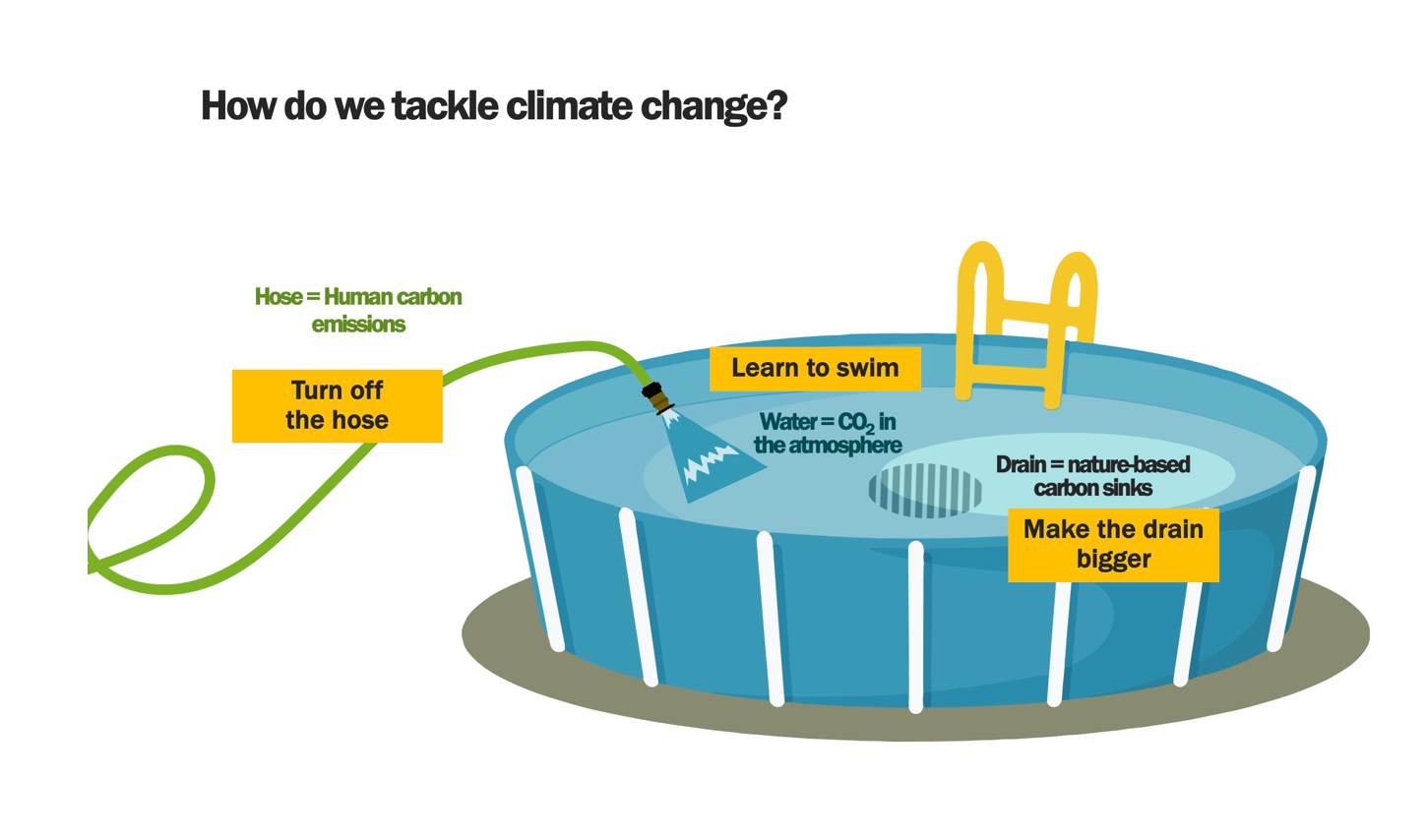BIO SECTION 3 ecology LECTURES 25-35
Lecture 25: commonness, rarity, and population processes in species
- Population: a group of individuals of the same species living in the same area that interact and interbreed
- Ecology: interactions between organisms and their environments
- Varying definitions of commonness in species:
-range size, local vs global abundance, local vs global biomass
- Bristol Whitebeam has restricted distribution-> only found in the UK
- Fire moss and brown rats are globally distributed(human activity)
- Temporal Shift: falcon->migration patterns change presence depending on the time of year->not all niches occupied at once
- Biomass measurements: measured through carbon-> Despite there being 40X more birds than humans, humans have 30x more carbon
- Humans and livestock make up most of the mammalian biomass
- Wild Land Animals: most species are rodents, individuals are bats, and biomass is ungulates(namely white-tailed deer)
- Patterns of Organism Dispersion: clumped, uniform, or random
- Organism dispersion is influenced by abiotic factors: temperature, sunlight, nutrient availability, and water/humidity, and biotic factors: food/prey, predators, and competition

- Populations change through birth and immigration and death and emigration
- N/t=(B+I)-(D-E)
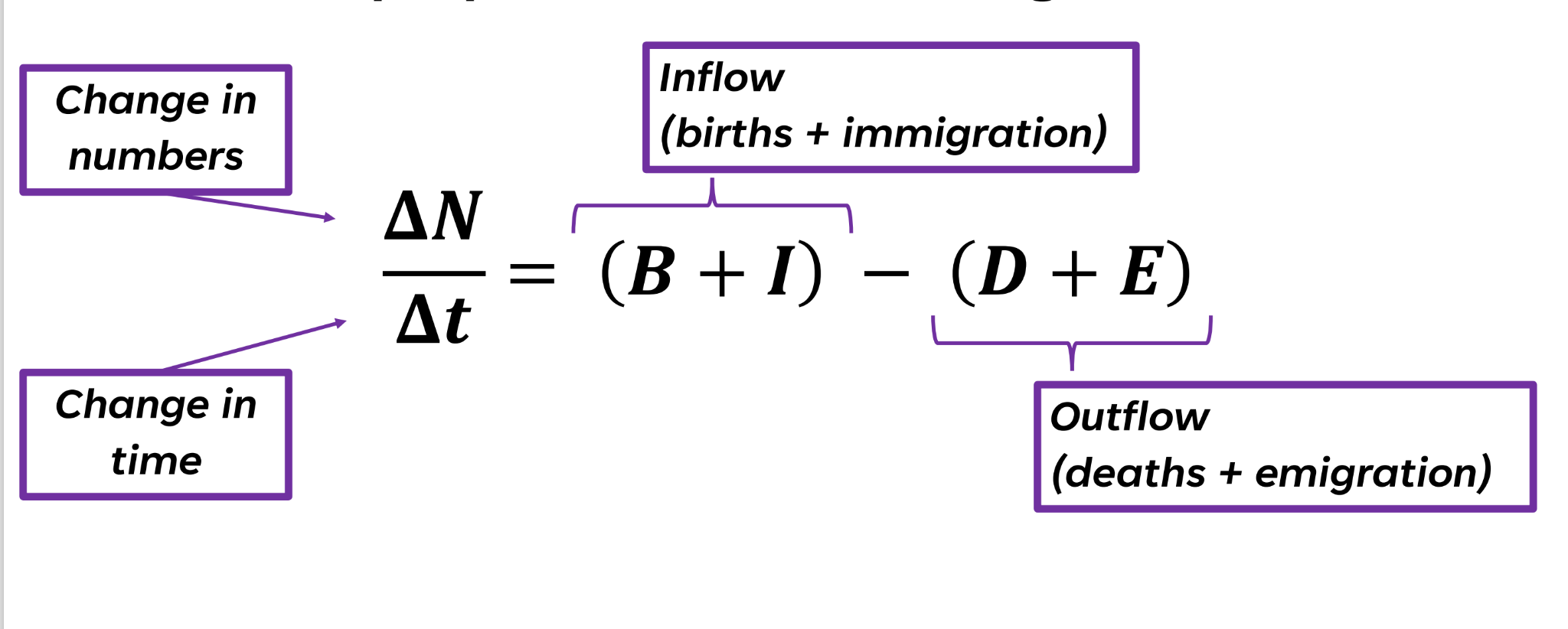
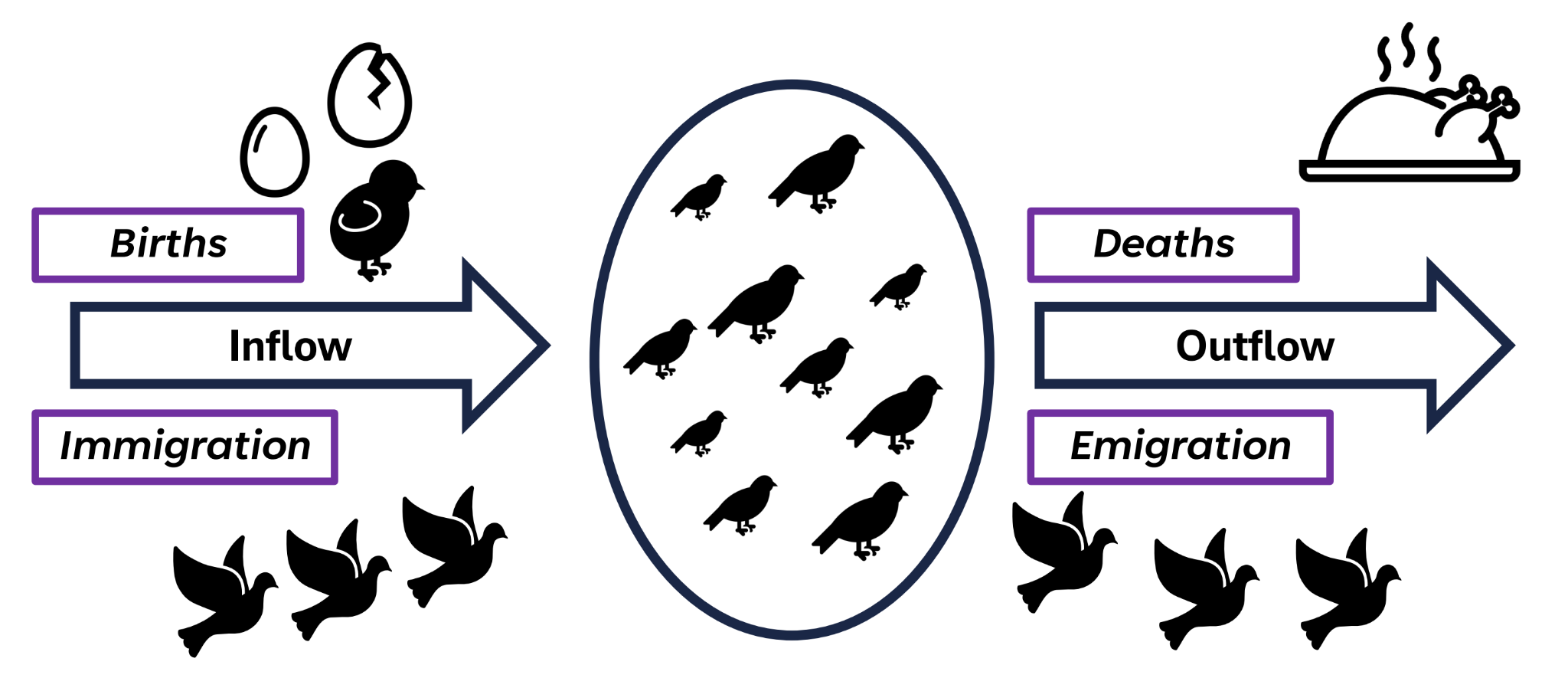
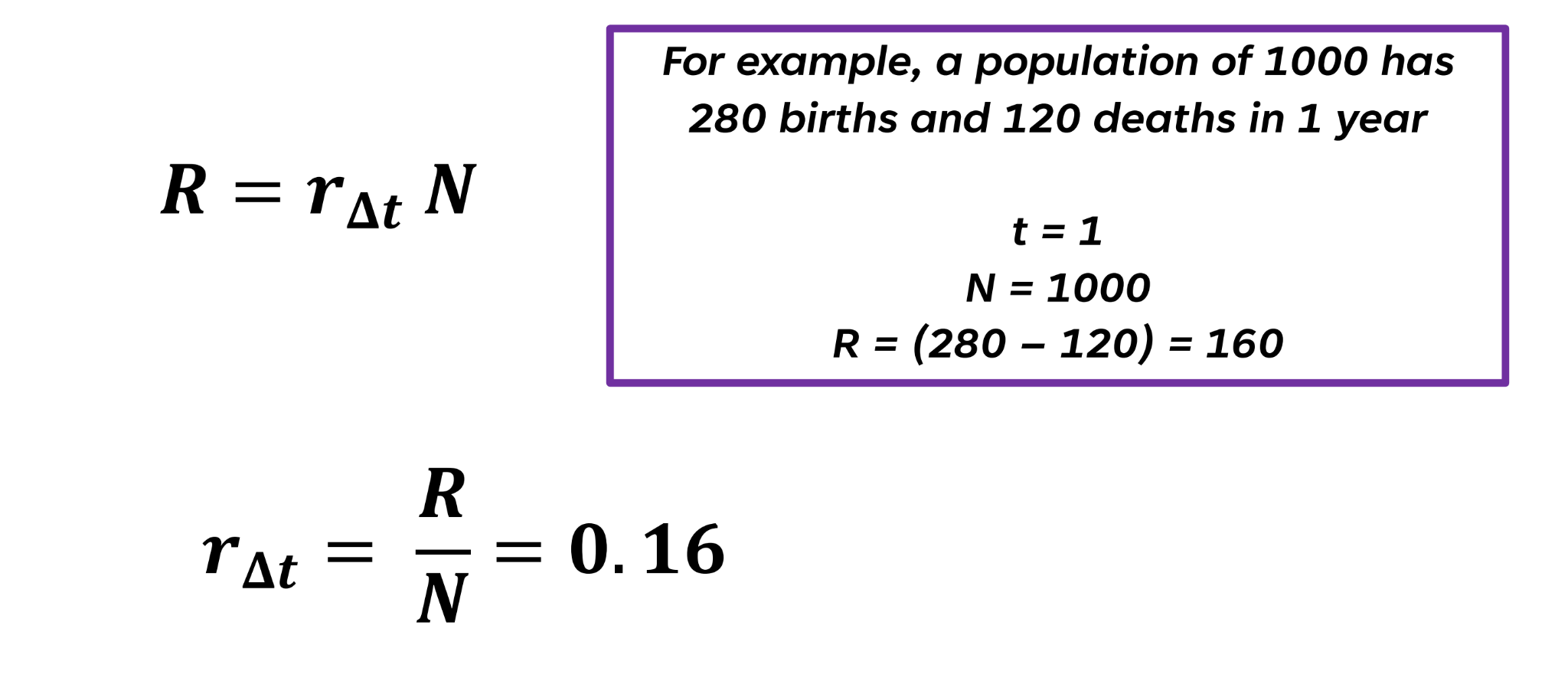
- exponential growth in nature requires unlimited resources
-occurred with reindeer on an island in Alaska
- K=carrying capacity=how many individuals an environment can maintain
- As population size, N approaches carrying capacity(K) growth rate(r) declines
- Destiny-dependent mortality: higher density=fewer hiding places from predators
- Populations are dynamic-> boom and bust cycle
-rapid growth in one population leads to decline in another-> food availability and predation risk contributes
- Risk of death generally increases with age->ground squirrels risk of death remains the same throughout life
- Different survival curves:
-type 1: humans-> lowest risk of death when young K selected
-type 2:squirrel->equal risk throughout life
-type 3:ants->highest risk when young r-selected
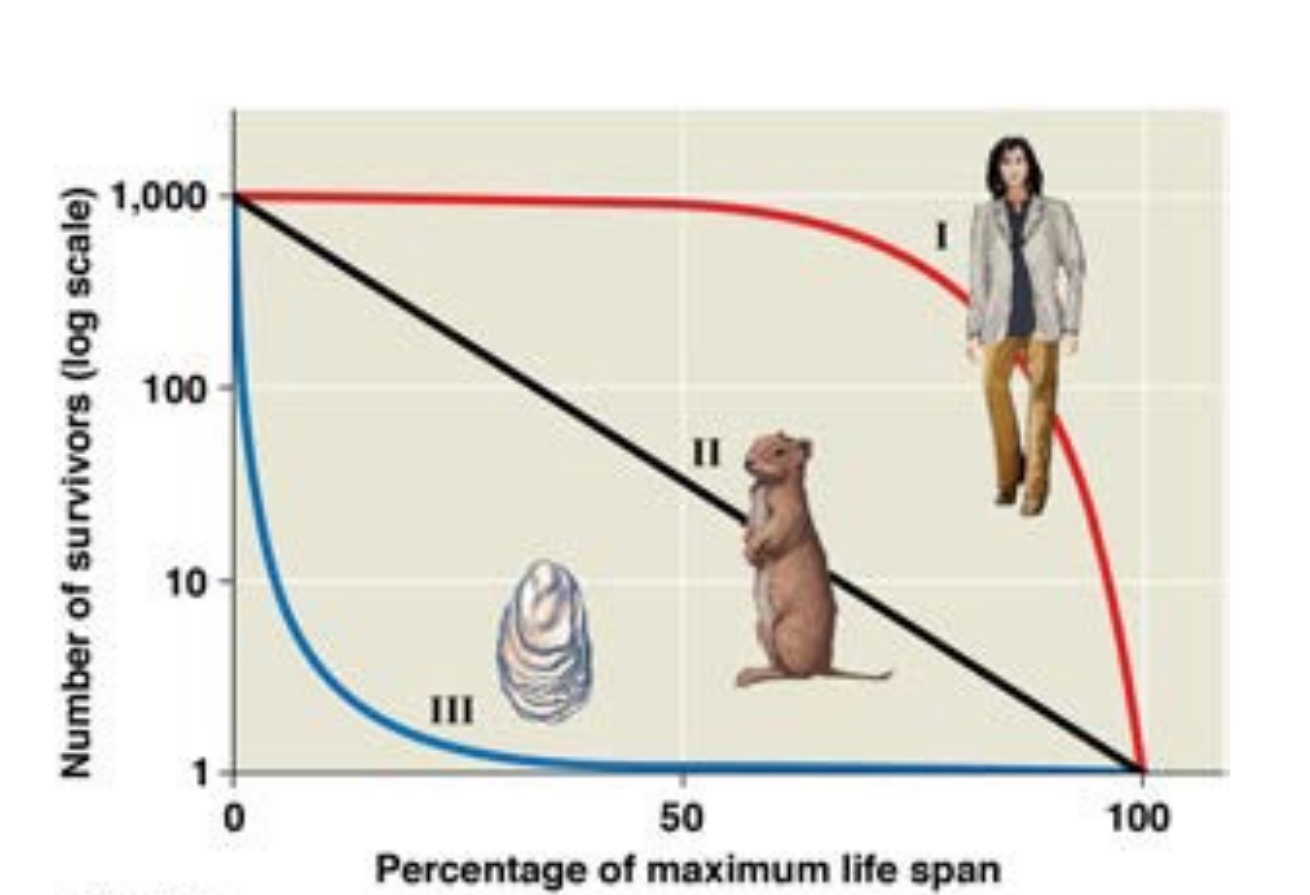
- Semelparity: breeding once in life
- Itereoparity: breeding multiple times in life
Lecture 26: conservation and biodiversity
- Community: populations of different species living in the same area
- Diversity is measured through species richness and species evenness
- Shannon Diversity Index: (pi=proportion of species i in community)

- Diversity is best protected by focusing on evolutionarily distinct species

- Foundation species: create structure and conditions necessary for ecosystem function
- Biodiversity allows for stability resilience and productivity
- More biodiversity allows for more ecosystem services
- Portfolio effect and redundancy: many species doing things in slightly different ways is more productive and stable
- The number of species on an island is dependent on its size
- Island biogeography is also depicted with human activity creating land islands
- Edges of areas tend to be less suitable habitat->more islands less suitable habitat
- Keystone species: disproportionally large effect on its environment compared to its abundance
- Most species have small geographical ranges
Lecture 27: Trophic Cascades and Rewilding
- Ecosystem: sum of all the organisms living in a given area and the abiotic factors in which they interact
- To function correctly landscapes must be big enough, connected enough, and incorporate all states simultaneously as well as allow disruptive influences such as fire to continue without dominating
- Environmental conditions are controlled by foundation species(bottom-up processes), keystone species(top-down processes), and environmental engineers such as beavers
- Low trophic levels: regulate productivity and land use
- High trophic levels: regulate consumption and behavior
- Food chains are not linear and have complex interactions
-more complex interactions resilience to disturbances
- Species interactions:
+/+=mutualism
-/+=parasitism
-/-=competition
0/+=commensalism
- Many rare species thrive in transitional habitats only after disturbances
- Rewilding: re-established ecological processes and ecosystem functions using natural management strategies and reintroducing native species
- High deer populations=high pressure on plants
-without predators, deers spend more time feeding and breeding rather than moving
- wolves=keystone species-> top-down effect of regulating species
- Trophic cascade: no more grey wolves in Yellowstone led to overgrazing due to rising elk population->ecosystem had fewer vegetation and species
- Having predators such as wolves on elk doesn't only decrease numbers but also changes behavior by having them move more frequently preventing overgrazing
- Understanding the natural ecosystem is vital in rewilding and misplacement can threaten habitats
-focusing on reforestation only threatens grasslands and wetlands
-African nonforest areas are threatened by the excessive planting of trees
Lecture 28: Constructing Ecosystems
- Photo and chemosynthetic organisms autotrophs convert environmental energy into organic compounds to be eaten by heterotrophs who feed on these producers
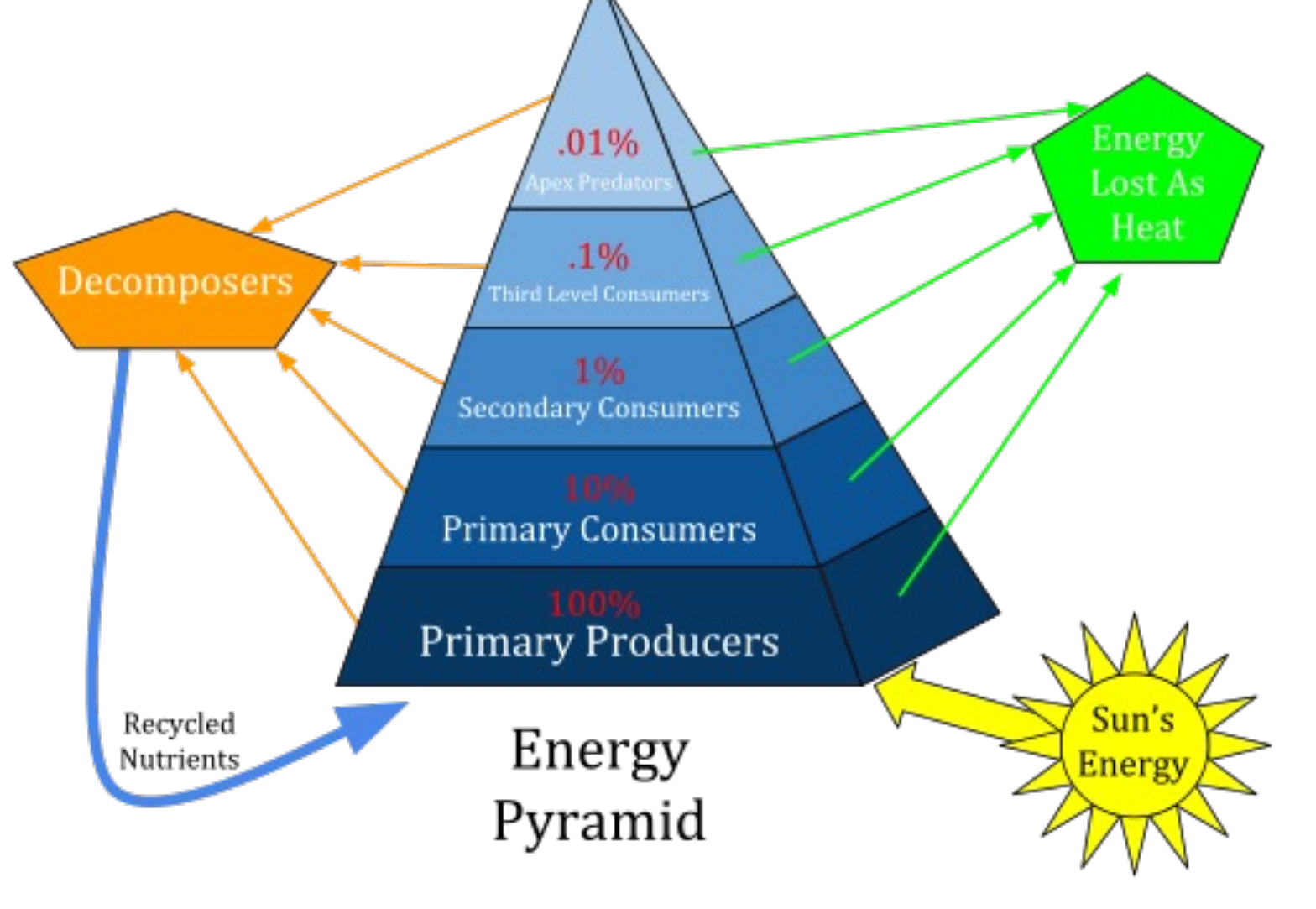
- Decomposers feed on dead animal matter
- Energy only flows 10% of each trophic level->ineffiecent
- Energy is only converted (law of conservation)
- GPP (gross primary production)=amount of energy converted into organic material by autotrophs
- NPP (net primary production)=GPP minus the energy used by autotrophs for themselves such as respiration
- NEP (Net ecosystem productivity)=total amount of biomass added to the ecosystem by all organisms
- Greater resource availability does not mean a more valuable ecosystem
- Limiting factors: prevent biomass from accumulating
-organisms cant grow if missing even one key resource
-bogs have water and sunlight but lack nutrients due to low oxygen
- Species can evolve to obtain lacking resources->plants in nitrogen-lacking soil obtain it from the gas in the air
- Draining of Irish bogs has positives and negatives:
-positive-> allows decomposition and more O2 access and releases carbon
-negative->increased erosion, eutrophication due to runoff, increase of generalist species, and loss of specialist species
- Agroecosystems: cropland or range lands
- Urban ecosystems: cities towns villages
- Semi-natural ecosystems: residential woodlands with high human activity and disturbance
- Forest clearing: most agricultural land created by forest clearing
-interrupts the water cycle with less photosynthesis and more erosion
-reduces water retention and increases temperatures
-thinner soils without roots are easily washed away
- Eutrophication: runoff from fertilizers causes an increase in nitrogen and phosphorus thus increasing algae growth leads to marine dead zones
-more algae growth-> no sunlight plants die to lack of O2
- Bioaccumulation: toxin build-up in the organism
- Biomagnification: toxins build up in higher trophic levels due to consumption of prey
- Ecosystems are becoming increasingly similar and less specialist species and more generalist species as they can usually outcompete in changing environments
- Phenology: timing and seasonal changes in species
- Time measured by temperatures and daylight
- Birds are getting out of sync as spring is happening earlier
Lecture 29: Urban Ecology
- Sex is determined by temperature in many organisms, not chromosomes
- Can either be a single critical temperature causing the change or males at intermediate temperatures with females at the extremes
- Tuatara->rising temperatures and social feedback loop with more males being produced leads to an extinction vortex
- Sea Turtles->more females leading to population boom with more nests
- Bateman principal: male skewed=lower reproductive potential, female skewed=higher reproductive potential
- ALAN=artifical light at night-> Robins begin singing one hour earlier and disrupt migration since they use visual cues and the earth's magnetic pull
-more instances of birds hitting buildings and different predators present
-fruit yields are lower in artificially versus naturally lit areas
- Human activity:
-mesopredators: decrease in apex with more domestic predators
-new diseases into the environment
-humans create islands with disruption of habitats
-new food sources->trash favors pests and more pests means more predators
-more shelter for animals-> sewers provide connection
-many birds being fed in the winter means less need to migrate
- Galapagos finches are defined by beak differences-> feeding on soft human food lessening the distinction between species
- Gulls are generalist species and are adapting to urban rather than sea environments
- Urban Heat Island: lack of trees and leads to urban environments being warmer by several degrees
Lecture 29: Natural Capital
- Nature intrinsic value: right to exist independent of humans
- Nature extrinsic value: Nature provides goods and services
- Natural capital provides direct benefits to humans from nature whereas ecosystem services are all contributing factors
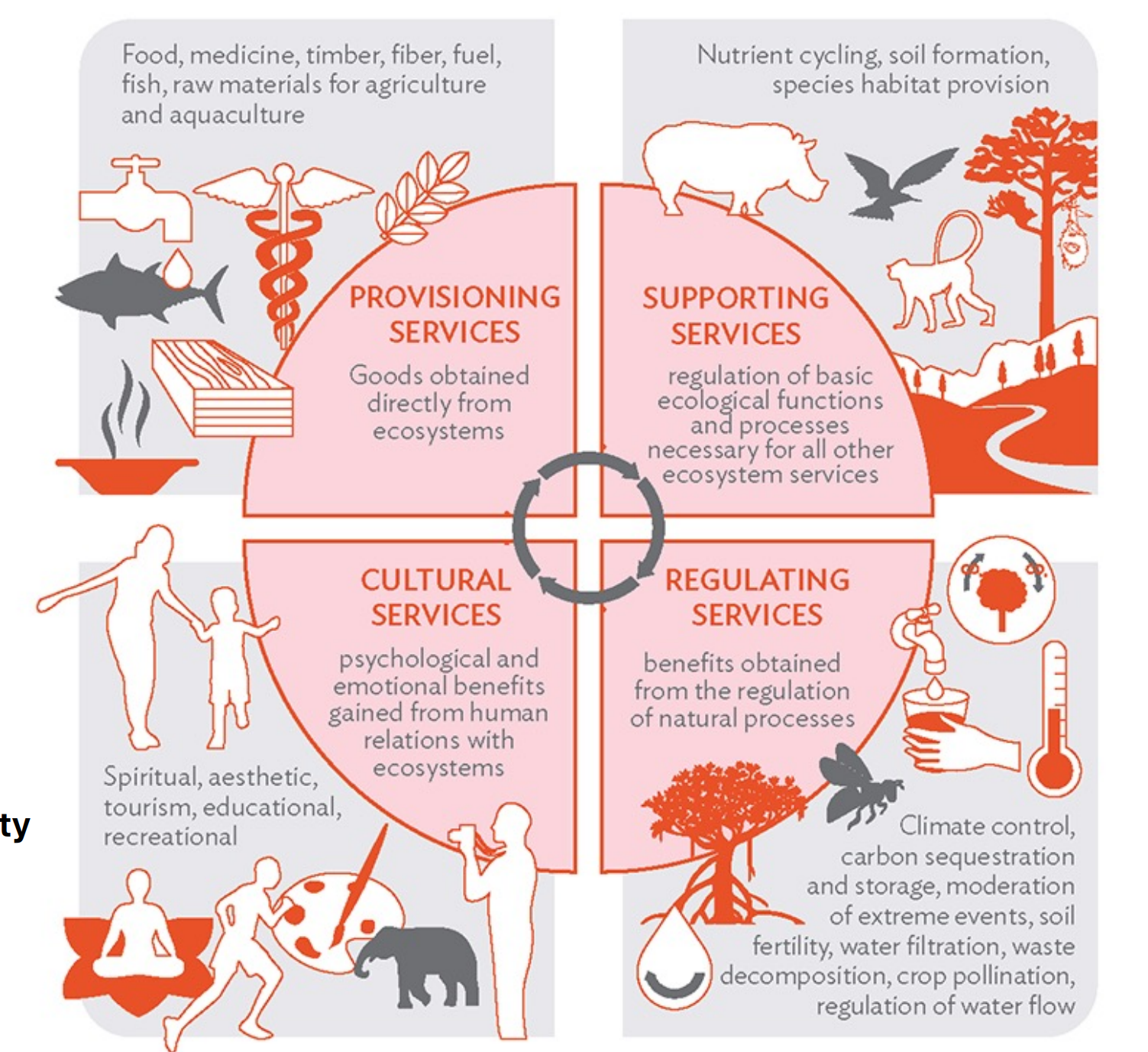
- Supporting, regulating, provisioning, culuteral=ecossytem services
- mangroves=transiotnal environment between land and oceans that are important for nurseries of fish
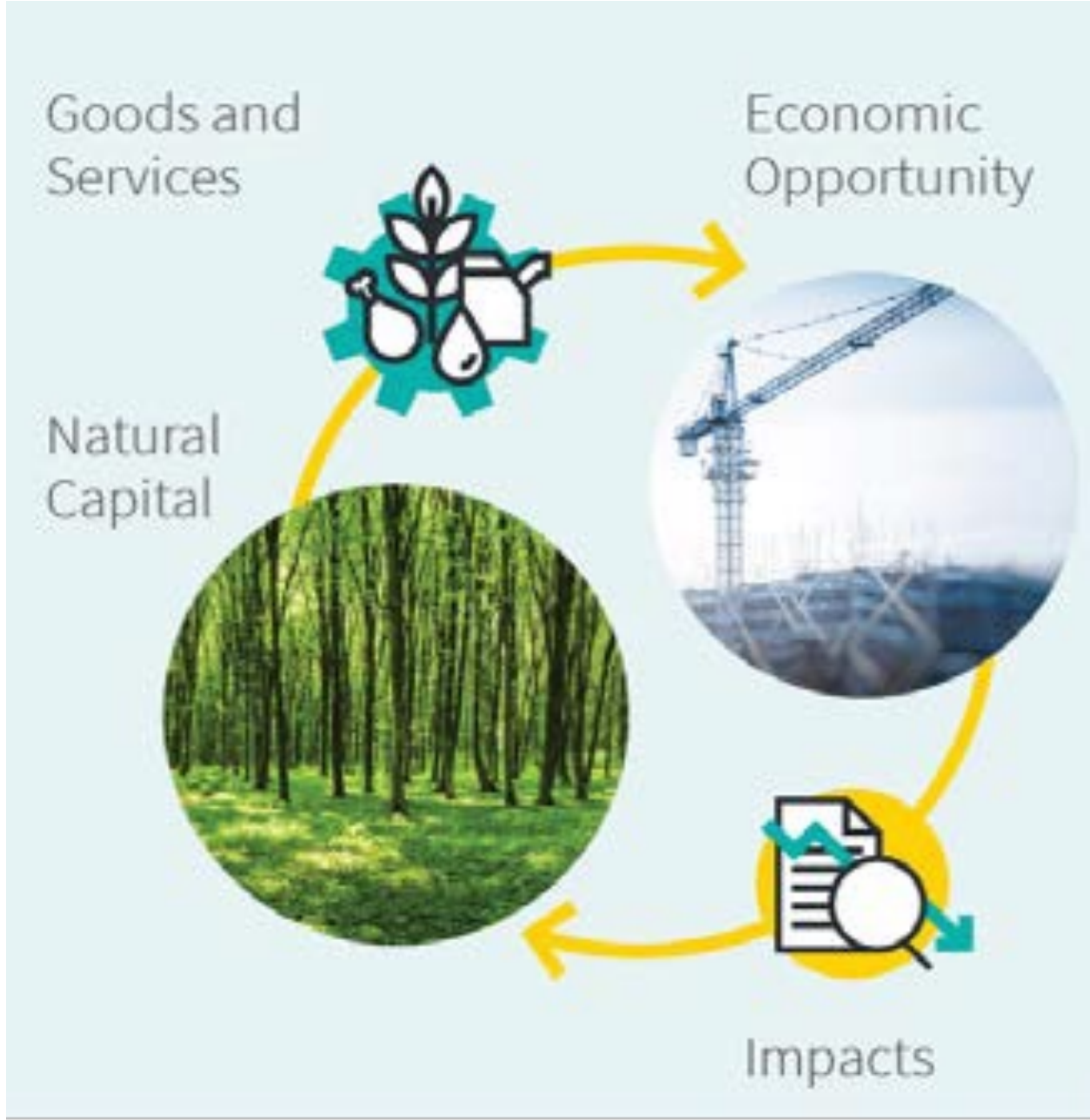
- Vultures provisioning services: feathers, genetic resources, hunting, medicine
- Regulatory: controls pests and regulates the food chain, Decreases CO2 by consuming dead organic matter
- Cultural: tourism and natural history make a widespread impact
- Bioaccumulation of drugs given to livestock leads to vulture death
- More carcasses of rotting vultures means more pests and diseases and a negative tourism perception
Lecture 32: Global Ecology and Climate Change
- Climate: the average or totality of the weather of a particular area over an interval of at least thirty years->one hot day isn't climate change it is weather
- Climate is important because it determines biology depending on the patterns in rainfall and temperature
- Ireland sits in the middle of global climate space within a huge vegetation zone-> significant climate changes are necessary before biological alterations
- In a country in a biome boundary-less change is needed
- Climate change is not restricted to temperature
-includes precipitation, atmospheric(greenhouse), pollutants
- Earth's climate has always changed ->happening more rapidly now due to human influence
- Oxygen isotope data: Deep ocean temperature record is based on the shells of single-celled organisms-> There has been long-term cooling for 65 mya
- CO2 emissions=main driver of climate change
- Mauna Loa; Hawaiian Volcano where CO2 levels are measured
-in the middle of the Pacific ->provides data within local sources of CO2 contaminating the data
-current levels=300 to 400 ppm
-minor oscillation in CO2 is due to more land mass in the northern hemisphere and during the winter less photosynthesis and more respiration produce more CO2->about 1 ppm difference in seasons
- CO2 levels have increased due to fossil fuel burning and land use
-removes carbon from long-term stores into the atmosphere
- Greenhouse effect: CO2, water vapour, and other greenhouse gases reflect infrared radiation toward earth increasing temperature
- There is 13ppm discrepancy between the amount of CO2 we would expect and the actual amount in the atmosphere that we don't understand
- IPCC: UN body for addressing climate change
- Tipping point: 1.5 C increase in temp will have severe consequences
- Unknown if it will be a positive or negative feedback loop
-Positive due to climate change will cause more climate change
-negative=change due to climate change will cause less climate change
- Energy supply-side actions: investing in solar and wind power
- Energy demand side actions: insulating home and reducing energy demand
- Solutions must consider human rights, tradeoffs, climate justice
- Paris Climate Agreement: 194 countries sign to keep Earth temp below 1.5 C
- Climate has warmed about a degree in the past century->faster than any other period
Lecture 33: Biological Niches and Climate
- Niche: interrelationship of a species (habitat, activity, resources) to environmental and biological conditions
-adaptations to different food and environments
- Ecology: study dealing relations of organisms to one another and their physical surroundings
- Niche construction: organism altering their environment
- Human heat stress: global mean warming of 7C would create zones where metabolic heat dissipation in humans would be impossible therefore questioning their habitability
- Climate envelope/niche: The range of temps within an organism is adapted
- Heat stress in trees doesn't kill trees directly but they become weaker so they are less able to battle disease and beetle infestations
-bark beetle infestation in SW USA forest die back due to warmer winters
- Phenology: seasonal and cyclical natural phenomena
-migration, hibernating, less bugs in winter
- Embolism: in plants formation of bubbles in the xylem (water-conducting vessels)
-droughts cause this and even when water is available often it is too damaged to take advantage and uptake the water
- Since species are adapted to specific temperature ranges they will move so they can stay in their tolerant range
-this movement causes increased contact between humans and diseased animals
-warmer temps mean a larger climate niche for malaria mosquitos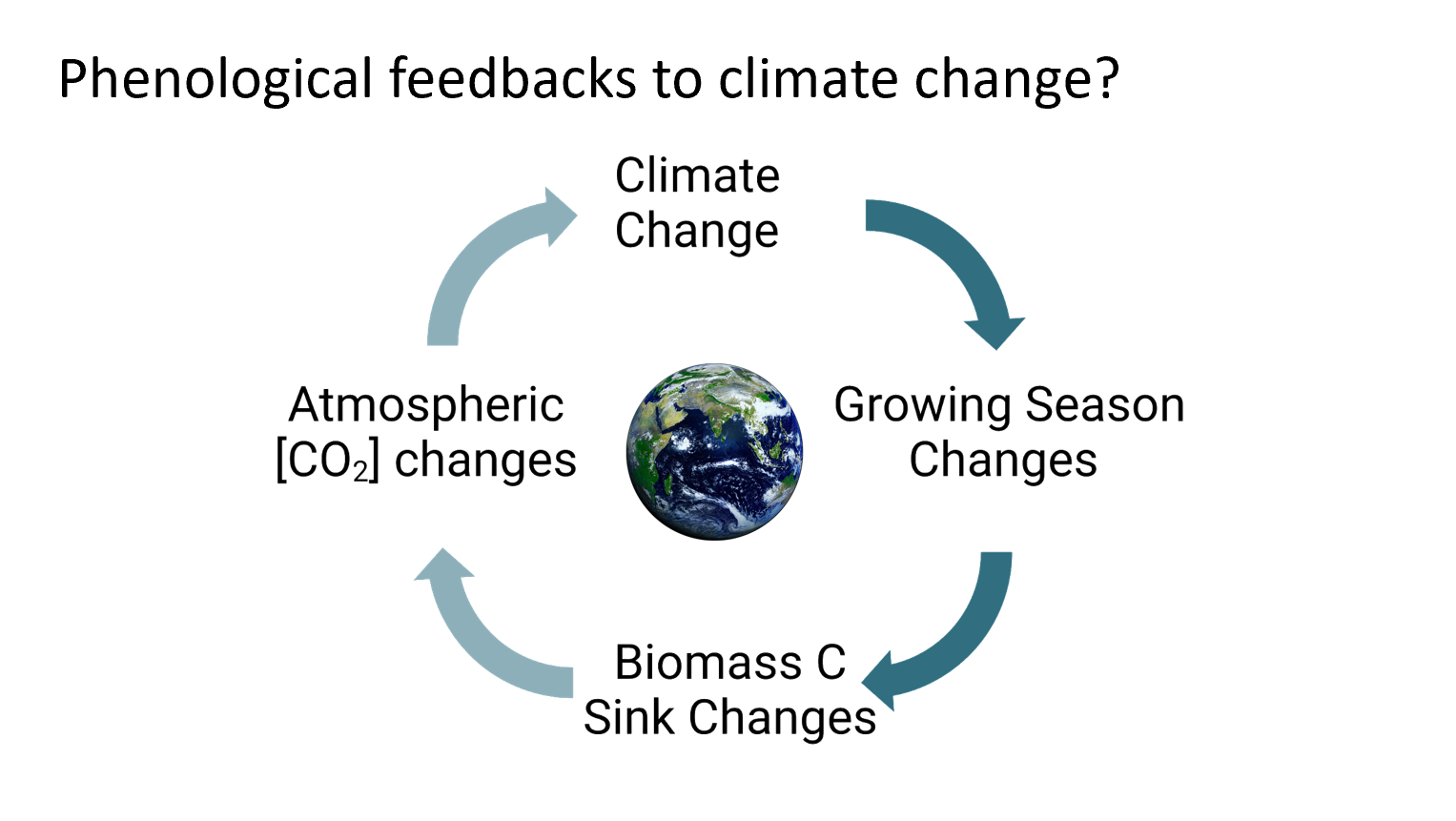
- Negative feedback loop: if growing seasons start earlier, carbon uptake starts earlier from the atmosphere-> more biomass production C out of the atmosphere
- Spring phenological events are occurring earlier due to global warming
-earlier in spring rather than extended to autumn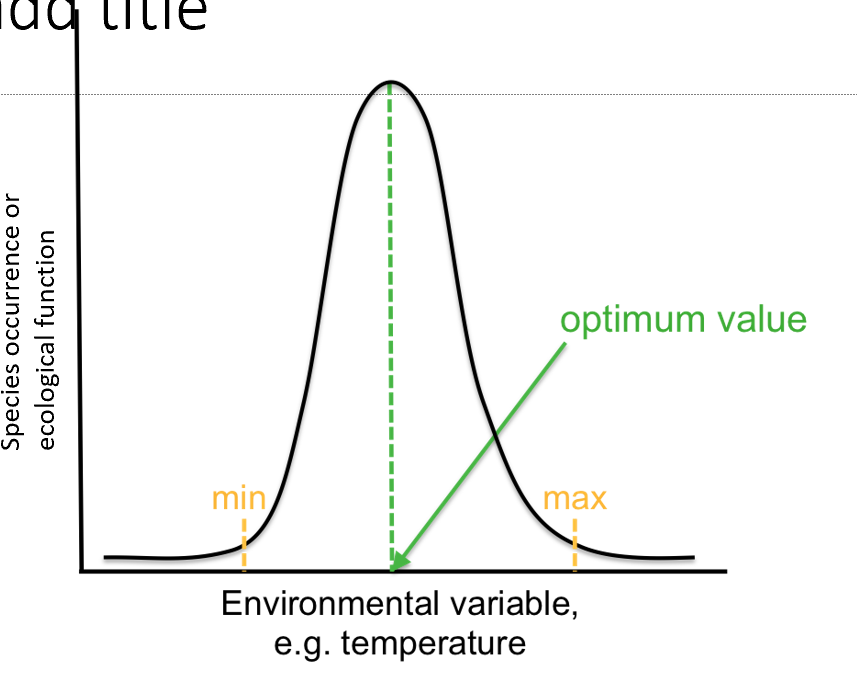
- Crop yields in low latitudes will drop 30 to 40 %
- Crop yields in high latitudes will increase due to more CO2 and higher temperatures
- Wheat crop yield may increase with more atmospheric CO2->orimary source of carbohydrate for the world
- The only effective way of mitigating carbon is photosynthesis#
- GPP increases with higher temperatures and more CO2 to use for photosynthesis
Lecture 34: Biomes and Global Productivity
- Biome: a similar ecosystem in different parts of the world determined by annual temperature and precipitation
-Savannahs and tropical forests are different though
- Tundra: treeless marshy plain soil frozen during the majority of the year
-within the Arctic Circle at sea level or high altitude on the mountains
-low temp low precipitation but waterlogged due to low drainage
-vegetation grasses and moss are able to photosynthesize at low temperatures and have freezing tolerance
-no trees->animals have thick coats and fat stores for insulation
- Boreal Forest: the world's largest biome only in the northern hemisphere
-temperature extremes and permafrost, acidic and nutrient-poor soil
- Temperature rainforest: high latitudes and altitudes with cool weather and high precipitation in both northern and southern hemisphere
-conifers dominate and Ireland and GB are a big fraction of this biome
-large precip with low evaporation with cloudy days
- Temperate broadleaf forests: have deciduous trees and cold winters and warm summers without no dryness extremes
- Grasslands: on the interior of continental masses and arid coastlines(temperate latitudes)
-lower precip, low nutrients in the soil, high range of temperatures
- Savannahs: dominated by grasses but found in sub-tropical areas have seasonal rainfall and are drought tolerant
-scattered trees can be present (ACACIA tree)
-intermediate biome between forest and grassland
- Grasslands and savannahs are prone to fires
- Although Ireland has a lot of grassland ecosystems it is not a biome due to human activity causing it-> lack trees due to human demands not naturally
- Desert: north and south hemisphere 20-30 latitude
-less than 250 mm of precipitation
-desertification: climate change causing savannas to become more like dessert
-no trees
- Mediterranean Scrub: hot dry summers with cool wet winters
-scrub and shrub vegetation with most growth during wet winters
-plants adapted to fire with seed germination depending on fire
-dominated by shrubs, not like savannas has no trees or grassland
- Tropical Forest: equatorial regions, constant rainfall, and little temp variation
-biodiversity hotspots, poor soil nutrients due to rapid nutrient uptake
-biggest tropical forest threat of climate change and deforestation for palm oil
- Productivity follows the gradient of light and water-like biomes
Lecture 35: Biogeochemical Cycling
- Plants are the most important organisms on earth for biogeochemical cycles
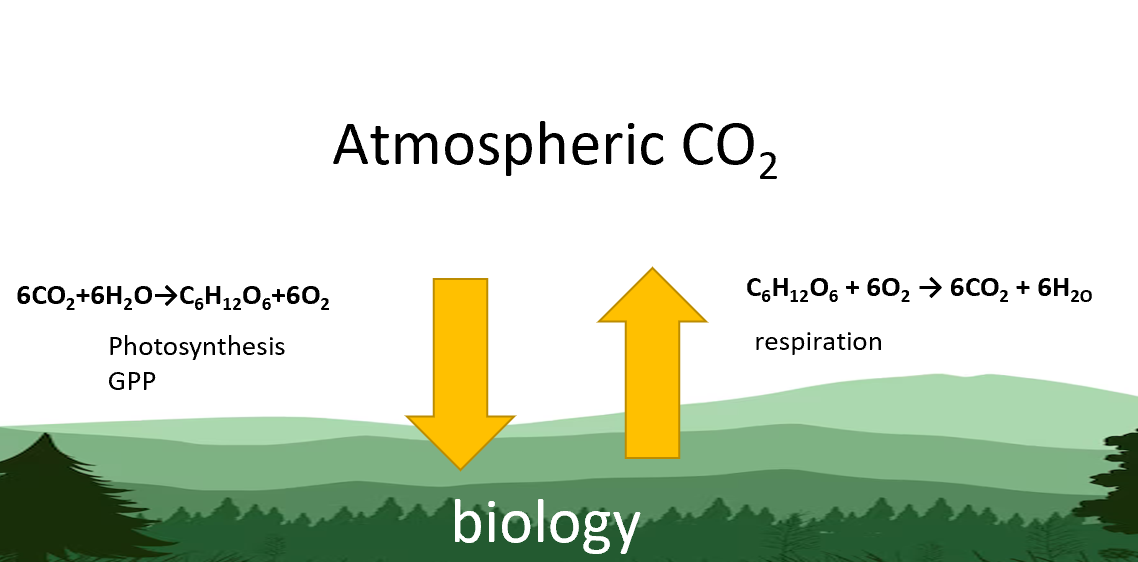
- GPP(gross primary productivity)=carbon flux->moves carbon from one pool to another, atmospheric carbon becoming living plant mass
- Amazon's drought in 2010 led to it becoming a source of carbon rather than a sequester
- water=90% of fresh weight in plants, plants are carbon hydrogen and oxygen
- Organisms need nitrogen for amino acids, proteins, and chlorophyll
-soils are becoming depleted and atmospheric nitrogen is hard to access due to triple-bond
- Organisms need phosphorus for DNA phospholipids and ATP
-only available from weathering of rocks
- At high altitude, nitrogen tends to be limited due to younger soils
- At low altitudes, phosphorus is limiting due to older soils
- Nitrogen cycling: rainfall without vegetation leads to nitrogen leeching so it is lost from land and causes eutrophication in runoff
Lecture 36: Biodiversity Loss
- Ireland voted to amend the constitution to protect biodiversity->could the first amendment addressing the crisis worldwide
- Declining due to landuse/change and habitat loss, pollution and eutrophicationm over exploiation and unsustainable land use, invasive speices, and climate change
- Red list provides information about extinction risk of species
- Targeted conservation acts are what is important
- 30X30->intiatiave to protect thirty percent of land and sea ecosystems by 2030 however the issues is neocoloniams or indigenous peoples rights because the person deciding what thirty percent to protect arent the same people living their
- Less than 40% of forests are more than 1 kiolmers away from an edge
-edge of a habitat is less ideal to live in for organisms
-due to humans dividing forests
- Ecosystem stability is increased with higher stability due to different species benefitting or losing out in extreme years it averages out
-less diversity less ecosystem services
- More invasive species can lead to more leaf area therefore more photosynthesis and thus more carbon uptake
- Also more decomposition so more respiration
